Building rustic chairs can be a fulfilling and enjoyable project if you're passionate about woodworking or simply want to add a cozy touch to your home. Creating your own rustic chair can be achieved with a few basic materials and some simple tools. A circular saw is a great tool for making precise cuts in wood, helping you create structural components like legs and supports efficiently. With a little time and effort, you can craft furniture that adds charm to any space.
Begin by considering the style you desire. Rustic chairs often have a natural, unfinished look that highlights the beauty of the wood. You can choose to use reclaimed wood or new lumber, depending on the appearance you're aiming for. Making your own chairs also allows you the freedom to customize the size and design to perfectly fit your needs.
Understanding Rustic Style

Rustic style draws inspiration from nature and emphasizes simplicity. Rustic furniture, especially chairs, offers an authentic feel with its natural materials and cozy, inviting atmosphere. Explore the history and key features that make these chairs unique.
History of Rustic Furniture
Rustic furniture has its roots in the 19th century when craftsmen in rural areas began creating durable, functional pieces from local materials. The style really took shape in American frontier cabins, where practicality and resource availability dictated design. During the Great Depression, rustic furniture gained popularity for its combination of functionality and comfort. Today, the rustic style is cherished for its handmade, authentic look that respects tradition and craftsmanship.
Characteristics of Rustic Chairs and Chair Legs
Rustic chairs are known for their robust design and natural materials. Most feature solid wood construction, often showcasing natural wood grains and textures that add to their charm. Comfort is also important, so you might find plush cushions on chairs designed for relaxation. The construction of chair seats, including selecting the right boards and dimensions for optimal strength and stability, is crucial to ensure they fit standard cushions effectively. Rustic chairs typically have a straightforward design, emphasizing durability and practicality over ornamentation. They often include elements like exposed hardware or distressed finishes, contributing to their authentic and timeless appeal. The beauty of this style lies in its simplicity and connection to nature, making each piece feel warm and inviting in any setting.
Design Considerations
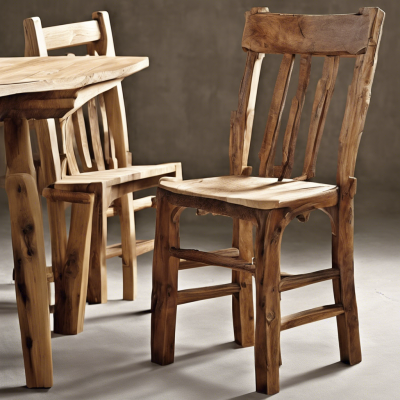
Building rustic chairs involves careful thought about materials, function, and style. You want to choose woods that can handle the demands of furniture use while fitting your vision for the piece. It’s important to think about how the chair will be used, ensuring it provides comfort and stability. Lastly, consider the visual appeal to ensure your chair looks as good as it functions.
Choosing the Right Materials
When making rustic chairs, the choice of materials makes a big difference. Using natural wood like cedar or pine is common due to their availability and ease of working. Each type of wood has unique features, such as grain patterns and colors, that can give character to your chair. Green wood, known for its pliability, is also an option, but it’s crucial to allow it to dry properly to avoid structural issues like warping and weakness.
Strong, durable wood is important, as rustic chairs need to withstand daily use. You may want to use branch sockets for parts of the chair like the legs. This is because they offer natural strength. Try to choose wood that’s free of too many knots, as knots can weaken the overall structure.
Reclaimed wood can also be a great option if you want to add an environmentally friendly aspect to your project. It also gives the chair more personality and history.
Functional Requirements
Before you start building, think about how the chair will actually be used. Consider factors like height, width, and depth to suit the intended users. It’s essential that the chair is stable and comfortable for long-term use.
Pay attention to the structure of the chair to ensure it can support weight effectively. Proper joint construction, like using wood glue or screws, can enhance durability. Drilling pilot holes before inserting screws or nails ensures secure joints and prevents the material from splitting. Building guides often recommend adding glue to joints for extra security.
Ergonomics are also important. A slight curve in the backrest can add comfort, and armrests can provide additional support. Ensuring ease of use and comfort aligns with the functional needs of a rustic chair.
Aesthetic Appeal
The look of your rustic chair is just as important as its function. Start by selecting wood with interesting natural patterns. Consider finishing techniques like stain or paint to enhance the wood’s beauty. A rustic look often means seeing imperfections as charming details rather than flaws.
The design should match other furniture if the chair is part of a set. Rustic chairs often emphasize natural elements, so keeping embellishments simple can add to their charm. You may want to experiment with distressed finishes for that authentic rustic feel.
Ultimately, your chair should reflect your personal taste. Using creative elements while staying true to the rustic style will result in a beautiful piece of furniture.
Tools and Safety
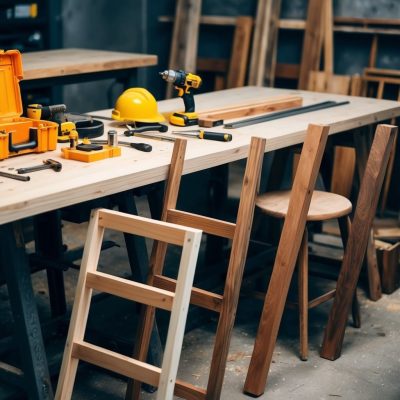
Building rustic chairs requires the right tools and a focus on safety. These elements ensure you create sturdy furniture while keeping yourself protected.
Essential Tools for Woodworking
When building rustic chairs, you’ll need a few basic tools. A good saw is a must-have for cutting wood to the right sizes. Many people use a handsaw, but if you prefer a quicker option, a power saw can help.
You’ll also need a hammer and nails for putting the pieces together. A drill is useful for making holes and securing screws, which can add extra stability to your chair. Additionally, using a pocket hole jig, such as the Kreg Pocket-Hole Jig 320, can facilitate positioning and drilling pocket holes in components like aprons and stretchers. Sandpaper or a sander will help you smooth the wood and remove any rough edges.
Lastly, don’t forget a tape measure and level. These will ensure your chair is sized correctly and stands evenly.
Safety Precautions
Safety should always be a priority when working with tools. Start by wearing protective gear. Safety goggles will keep your eyes safe from flying wood chips. Investing in a good pair of work gloves can protect your hands from cuts and splinters.
Make sure you have a clean, organized workspace. This reduces tripping hazards and keeps tools from falling unexpectedly. When using power tools, keep the cords out of the way to avoid tangling or tripping.
Always follow the instructions for each tool, especially power tools. It’s also smart to keep a first aid kit nearby for minor injuries. And remember, never rush; careful work is safer work.
Selecting Wood

When building rustic chairs, choosing the right wood is important. Different wood types can offer unique textures and characteristics to your chair. You also need to prepare the wood properly to ensure it is ready for crafting.
Types of Wood for Rustic Look
Choosing the right wood can greatly impact the final look and durability of your chair. White oak is a popular choice for rustic furniture thanks to its strength and ability to be steam-bent, making it ideal for spindles and other parts. If you’re aiming for a smoother and richer-looking finish, you might consider walnut, which offers a warm, rich color. For an option with a beautiful grain pattern, sycamore can be a good choice, though you should be cautious about its tendency to warp. Red oak might have a grain that some find less appealing, but it works well for most chair parts and is sturdy.
Explore rustic options like reclaimed or pallet wood, adding history and charm to your project. Pallet wood chairs can convey a unique rustic feel. Remember, reclaimed wood often has knots and imperfections, which contribute to the charm of rustic furniture.
Preparing the Wood
Once you’ve selected your wood, preparation is key. Begin by inspecting for any damage or imperfections. Sand the wood to ensure a smooth surface, which helps with applying finishes later. If you’re using pallet wood or reclaimed wood, this step is especially important.
Next, use wood filler to fix any cracks or holes. This adds strength and improves appearance. Depending on the type of wood, applying a finish like oil or stain can enhance the wood’s natural beauty and protect it from wear and tear.
Cut your wood pieces to size according to your design, ensuring accuracy. Properly prepared wood will help you build a durable and attractive rustic chair.
Creating the Chair Design

When designing a rustic chair, it’s important to focus first on planning your design and then determining the right dimensions for comfort and style. These steps are crucial for creating a chair that looks great and feels sturdy.
Drafting a Plan
Start by deciding on the style and features of your rustic chair. Consider whether you want a simple design or something more elaborate. Look at different styles online for inspiration.
Make a list of materials you’ll need, such as wood types, screws, and glue. Using solid ash or other durable woods is a good choice for long-lasting chairs. Gather the necessary tools too, like a saw, clamps, and a screwdriver.
Next, sketch your ideas on paper. This helps you visualize the shape and parts of the chair. Draw out the seat, backrest, and legs, paying special attention to how they connect. Be detailed so you have a clear guide when you start building. Emphasize the importance of attaching various components, including cross pieces and backrests, to create a stable and visually appealing chair frame.
Determining Dimensions
Get the dimensions right to ensure the chair is both comfortable and stable. Start by deciding how high the seat should be from the ground. A typical chair seat is around 18 inches high, but adjust based on personal preference.
Set the width and depth of the seat. Generally, a seat width of about 20 inches offers enough space for most people. The seat depth should provide comfort without making it hard to stand up.
Focus next on the height and angle of the backrest. A backrest around 12 to 20 inches high with a slight recline can provide good support and comfort.
Check other chairs you like and measure them as a reference. This will give you a better idea of what dimensions will work best. Adjust by adding personal touches that make the chair uniquely yours.
Cutting and Assembling
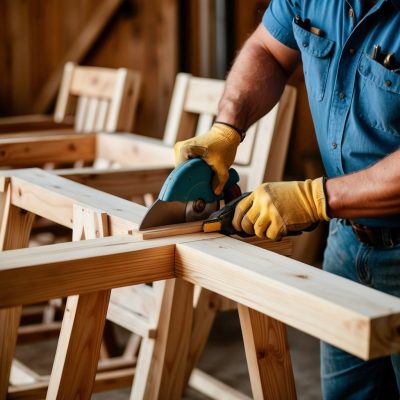
To build a rustic chair, you’ll need to focus on two main tasks: cutting the pieces accurately and using reliable assembly techniques. Both of these steps ensure that your chair is sturdy and fits together nicely.
Cutting the Pieces with a Circular Saw
Start by selecting your lumber. Common choices include 2x4s or 2x6s for the chair’s frame. If you want to follow specific plans, consider using the steps from the DIY Plan website, which outlines detailed cutting instructions. For the backrest, legs, and seat, make sure you measure each piece carefully to match the dimensions required. Use a saw that you can handle safely, such as a miter saw, to achieve precise cuts. Precise measurements and techniques are crucial in constructing sturdy chair legs, highlighting both the aesthetic and functional aspects that affect the overall stability and comfort of the chair design.
Sand the edges to smooth out rough spots. This reduces the risk of splinters and helps the pieces fit together better. Pay careful attention to the angles needed for each cut, as these affect the chair’s stability. By taking your time and focusing on each piece individually, you’ll create a more polished final product.
Assembly Techniques with Wood Glue
After cutting, it’s time to put all those pieces together. Start by assembling the legs and backrest. Integrate the back legs with the front legs to create stable leg components, ensuring sturdy joints between the backrest and back legs. You can use wood glue for additional stability, followed by screws to secure the parts.
Use pocket holes and screws to connect the parts, which add extra strength and a cleaner look. Connect the front legs to other structural components with precise measurements, angles, and joinery techniques. When attaching the cross rails, make sure they are evenly spaced and aligned. Ensure the positioning and stability of the rear legs within the overall structure of the chair. A clamp can be useful to hold pieces in place while you fasten them. Taking care during assembly will help ensure your chair is both strong and attractive.
Finishing Touches

Adding the final touches to your rustic chair can make a big difference in its appearance and durability. Focus on sanding for a smooth finish and applying stain and sealant to protect the wood.
Sanding for Smoothness
Sanding is crucial for achieving a smooth, comfortable chair. Start with a coarse sandpaper, around 80 grit, to remove any rough edges from the wood. Make sure to sand along the grain to avoid scratches. Work your way up to a finer grit, like 220, to achieve a soft, polished feel.
Pay extra attention to corners and edges, making sure they are rounded and splinter-free. Additionally, ensure each chair leg is thoroughly sanded and prepared to guarantee proper alignment and stability during assembly. After sanding, wipe the chair with a damp cloth to remove dust. This step ensures that the surface is clean and ready for the stain.
Applying Stain and Sealant
Choose a stain that enhances the wood’s natural beauty. Use a brush or cloth to apply an even coat, working with the grain. Allow the stain to penetrate for a few minutes before wiping off any excess with a clean cloth.
Once the stain is dry, apply a sealant to protect your chair. A topcoat of water-based polyurethane is a good choice, as it’s easy to clean and doesn’t yellow over time. Apply at least two thin, even coats with a brush, allowing each to dry completely. This will ensure your rustic chair is both beautiful and durable.
Decor and Enhancement

When building rustic chairs, decor and enhancement are key in making your piece stand out. Custom carvings and the addition of fabric or leather can add unique flair and personalization to your chair.
Custom Carvings and Details
Custom carvings can bring character to your rustic chair. Start by choosing a pattern or design that fits the overall style you want. You can use simple shapes or more intricate motifs, depending on your skill.
Tools like chisels and carving knives are essential. They allow for precision and help achieve the desired look. Safety goggles and gloves are recommended to protect yourself while working. You can enhance carvings by sanding the wood smooth and applying a stain or finish to highlight the designs. This not only beautifies the chair but also protects the wood from wear.
Adding Fabric or Leather
Adding fabric or leather can provide comfort and style. Choose materials that are durable and match the aesthetic of your chair. Design elements that cater to comfort and aesthetics for the dining room space are important, showcasing how building techniques can yield suitable rustic furniture for dining settings. Leather is often used for its rustic appeal and durability, while fabric can offer more variety in patterns and textures.
To attach fabric or leather, you’ll need a staple gun and upholstery nails or tacks. Measure the dimensions of the seat or backrest accurately before cutting your material. Stretch the fabric tightly over the seat and secure it with staples underneath. Leather can be conditioned to keep it soft and prevent cracking over time. For a professional touch, consider adding decorative trim or stitching.
Maintenance Tips
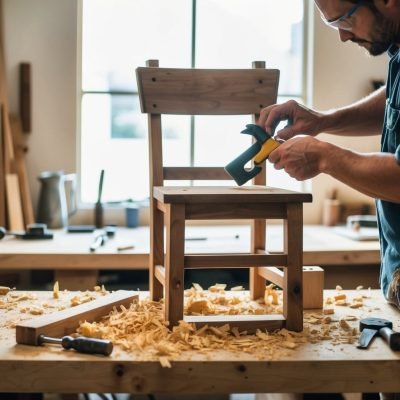
Taking care of your rustic chairs ensures they last longer and maintain their charm. Key tasks include regular cleaning and attending to any necessary repairs.
Cleaning and Care
To keep your rustic chairs looking great, regular dusting is essential. Use a soft, dry cloth to gently remove dust and dirt. For intricate carvings, a soft brush can help reach those tricky spots. When cleaning stubborn stains, mix a mild cleaning solution and apply it with a slightly damp cloth. Avoid using water-soaked cloths, as excessive moisture can damage the wood. Instead, dry the surface immediately after wiping. Furniture polish or wax can enhance the wood’s shine, but don’t use too much. It can make surfaces feel sticky over time.
Repair and Restoration
Rustic chairs might get scratches or dents over time, adding character to their appearance. Small scratches can often be fixed with a furniture touch-up marker that matches the chair’s color. For deeper dents, gently sanding the area and applying wood filler might do the trick. Once dry, sand the area smoothly and finish with a stain that matches the rest of the chair. Loose joints may need a bit of wood glue to strengthen them. Apply glue, press the parts together, and clean any excess to keep your chairs robust. Regular checks can help you spot and fix issues early, making sure your chairs stay sturdy.
Sourcing Ethical Materials
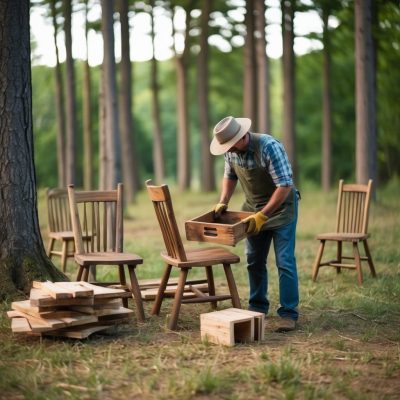
Finding the right materials for building rustic chairs ensures that your projects are both beautiful and eco-friendly. By choosing ethical materials, you can have a positive impact on the environment and create furniture that truly stands out.
Recycled and Sustainable Options
When it comes to ethical materials, recycled wood is a great
Webbing Collar,Webbing Dog Collar,Webbing Collars Dogs,Printed Webbing For Dog Collars
Wenzhou Vigorous Pet Products Co.,Ltd , http://www.vigorouspet.com
![<?echo $_SERVER['SERVER_NAME'];?>](/template/twentyseventeen/skin/images/header.jpg)